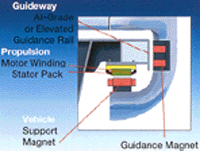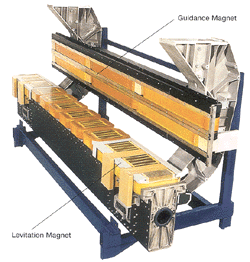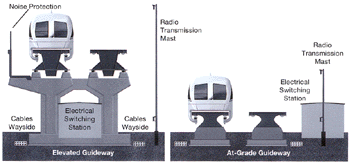|
| A Simple Lesson About MAGLEV |
| The Levitation System |
Electronically controlled support magnets located on both sides along the entire length of the vehicle pull the vehicle up to the ferromagnetic stator packs mounted to the underside of the guideway.
Guidance magnets located on both sides along the entire length of the vehicle keep the vehicle laterally on the track. Electronic systems guarantee that the clearance remains constant (nominally 10 mm). To hover, the MAGLEV requires less power than its air conditioning equipment. The levitation system is supplied from on-board batteries and thus independent of the propulsion system. The vehicle is capable of hovering up to 30 minutes without external energy. While travelling, the on-board batteries are recharged by linear generators integrated into the support magnets.
|
|
  |
| Guideway Systems |
 |
The MAGLEV hovers over a single or double track guideway. It can be mounted either at-grade or elevated on slim columns and consists of individual steel or concrete beams up to 62 m in length.
To change tracks, bendable switches are used which consist of a continuous steel beam which is elastically bent by means of electro-mechanical setting drives. Low speed switches, approx. 78 m long, are used to change tracks near stations and can be passed over in the turnout direction at 100 km/h (in the straight direction at full operating speed). High speed switches, approx. 150 m long, are used where higher turnout speeds are required (200 km/h turnout speed and in the straight direction at full operating speed).
Take a look at a switch in action.
|
|
Propulsion and Power |
 |
The MAGLEV is propelled by a non-contact, long-stator |
|
|
|
|

